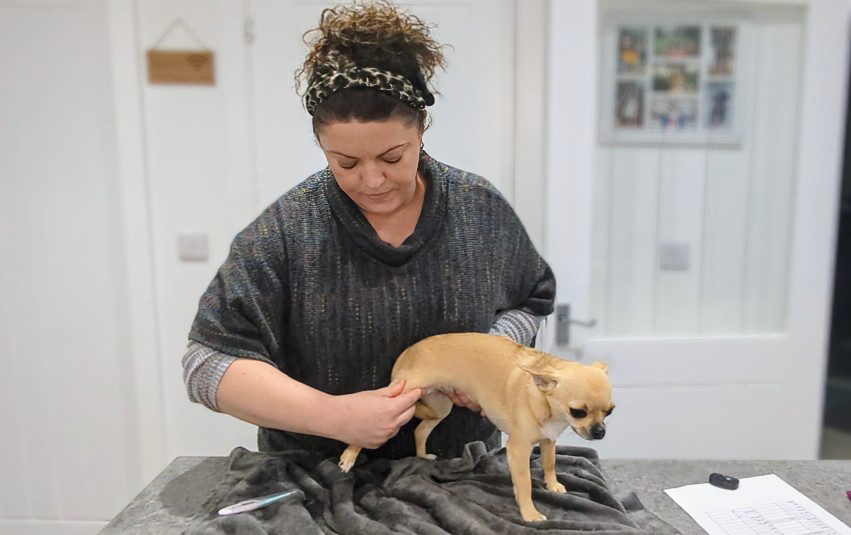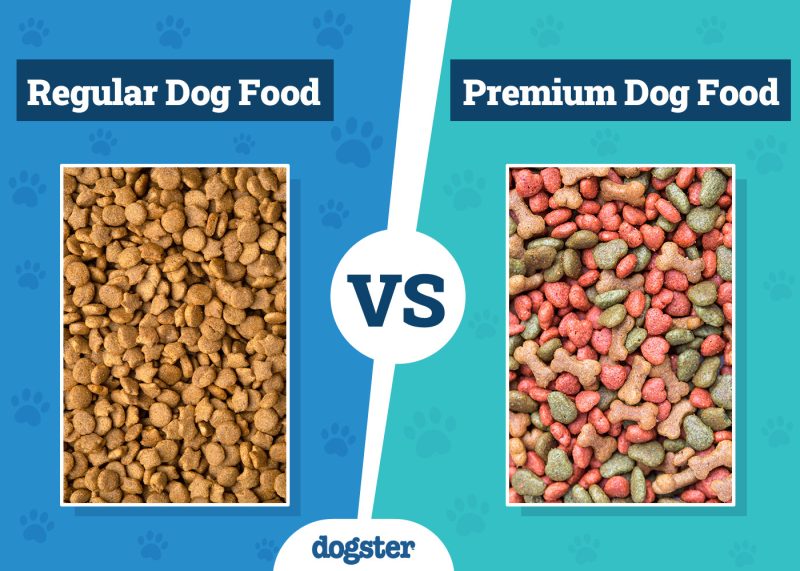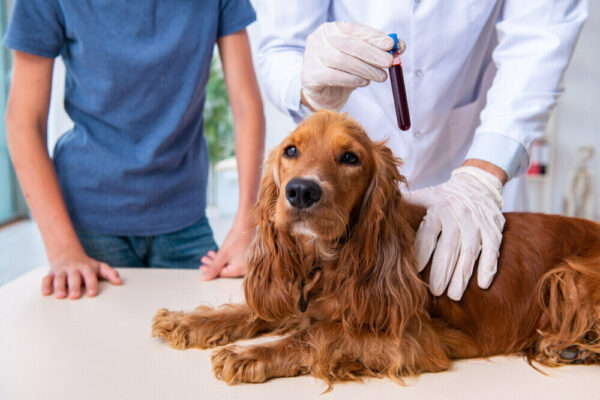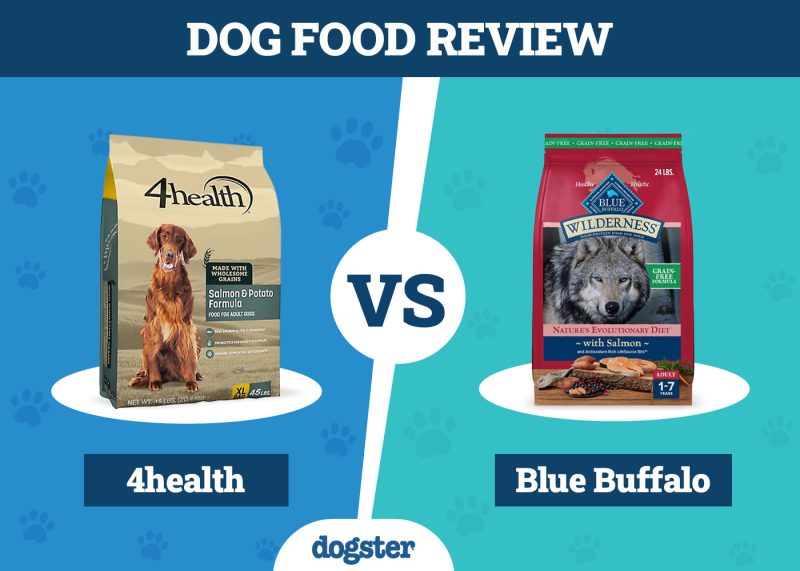Hi, I’m Dr. Karyn! Read my introduction to learn more about me and my five funny dogs, Poppy, Bailey, Kodah, Ned, and Fred.
Recently I was working on a Dogster article called “How Do I Know If My Dog Is Healthy?” and it made me think about the examination I perform when I’m giving a dog a basic health check. And then I thought back to Covid lockdowns, and how we were often relying on owners to examine their dogs at home to help us decide if they needed to bring them into the vet clinic. These basic checks are something I don’t even think about, but that’s because in clinical practice, we do hundreds of them every week. But I started to think about how overwhelming it may be for someone who has never done one.
So, with the help of my pack of willing volunteers, I am going to show you how to perform a basic physical examination of your dog at home using a checklist. Not only can this be helpful for remote vet checks, but it’s also a great way to have some baseline measurements and monitor health conditions at home.
Of course, a home health check is NOT a substitute for a complete veterinary examination, and there are limits to what we can measure outside the vet clinic. However, being able to properly assess your dog can provide useful insight for your vet, allow you to get a clearer idea of how they are responding to treatment, and help you pick up potential problems sooner.
The Ten-Minute Health Check
Click here to download and print our health checklist.
You can use this checklist to help guide you through this basic examination and record what you find. It’s a good idea to fill out the checklist at, or just after, a check-up at the vet. That way you will have an accurate weight measurement, and you can find out what your pet’s ideal weight is.
The only equipment you’re going to need is a watch/clock and a rectal thermometer, which you can purchase specifically or commandeer from your first aid supplies – just be sure to label it clearly and keep it separate from any human equipment!
TPR
Temperature, pulse, and respiration: the hallmark of examination, patient monitoring, and triage.
Heart Rate
We’re not using a stethoscope, and this does not replace a cardiac auscultation. We are simply measuring the heart rate. You can either take a reading over a full 60 seconds, or for 15 seconds and multiply it by four. There are a few places that you can use to check your dog’s heart rate:
| Carotid artery – located in the jugular groove, either side of the trachea (windpipe) on the neck. | 
|
| Chest wall (left side) – on lean dogs, you should be able to feel (or even see) your dog’s heart beating under their ribs around where their elbow is when they are standing. | 
|
| Femoral artery – this can be felt when your dog is standing up or lying down. Place your fingers in the groove between the thigh muscles just below your dog’s groin. | 
|
Respiratory Rate
This will fluctuate a lot when your dog is awake, so wait for them to be asleep to take this reading. Fortunately for me, that is very easy when it comes to Ned & Fred…slightly trickier with Kodah!
Temperature

Not all dogs will be amenable to having their temperature taken, and it’s not something you should risk harming them or yourself over. If you can’t get a thermometer in for a rectal temperature, have a feel of their ears, nose, and paw pads. Although this won’t give you an accurate temperature measurement, it can give you an idea of whether they feel warm or cold in relation to the ambient temperature. For example, warm ears on a cold day may indicate a fever.
Always take temperature last, as pulse and respiratory rate are likely to go up once that thermometer gets near their bottom, and be sure to use a personal lubricant or Vaseline on the thermometer!
Gums
Healthy gums should be salmon pink and feel moist to the touch. Many dogs have dark brown or black pigment on their gums, making this a little harder to assess, but you should be able to find an area without pigmentation to use.
CRT
Capillary refill time (CRT) can give us an indication of blood pressure, anemia, or blood loss. Find a pink area of the gum and carefully push your finger against the gum so that it blanches white. Measure how long it takes for the color to return.
Normal CRT is around 1-2 seconds.

Ocular Exam
We’re not going to get too complicated with this one. These checks will just give us an idea if there is any pain or vision loss.
Eyes
Are they of equal size and appearance? Is there any redness or discoloration?
Pupils
Are they the same size? Do they constrict (get smaller) in the light and dilate (get larger) in the dark?
Dazzle
If you flash a torch/bright light into the eyes, do they close their eyes?
Menace
Hold one hand over one eye, and with the other hand, quickly approach the open eye as if you are going to hit it, but stop about 8 inches from the face – does the eye close? Repeat on the other side.
Comfort
Do they mind if you push gently on the eye over the eyelid?
Gastrointestinal System

Some basic questions to answer are:
- Has your dog’s appetite been normal? Increased? Decreased?
- Has there been any vomiting or diarrhea?
- Is their abdomen comfortable and soft if you push on it, or does it seem tense, painful, or bloated?
Skin
Skin problems are one of the most common reasons for dogs to end up at the vet, and if your dog has any obvious or significant skin issues, they will need a separate examination with your vet. In this situation, we’re just looking for any early or subtle signs of a problem (or lack of one!). Don’t forget to check the ears and feet.
You want to look for redness, greasy coat or skin, scabs, crusts, or bald patches. This is also a good time to feel over their body for any lumps or swellings. Use the diagram on the checklist to make notes of any lumps you find.
Musculoskeletal Exam
Dogs are great at just getting on with their day, and this often results in owners getting the impression that they aren’t in any pain. The fact is that if your dog has any lameness or changes in how they walk (gait), it is a sign of pain or a neurological issue, so being able to check this at home can fast-track your dog to the treatment they need. Here are some things to look out for:
Gait
Is there any sign of lameness or unusual limb movements? Are they scraping the claws on any feet?
Neck
Carefully move your dog’s head to point up, down, left, and right, making note of any stiffness or pain.
Spine

Slowly run the palm of your hand over your dog’s back, using medium/firm pressure. Look for any flinching or turning of their head, and make notes on the diagram of any areas that seem to trigger a reaction.
Tail
Check for changes in position, pain, or swellings, and be sure to check the upper and lower sides.
Limbs
Systematically work your way up from the toes to the shoulder and hip, gently squeezing along the limb, and flexing/extending each joint, watching your dog’s face as you do it. Most dogs will whimper or cry if the pain is bad enough, but others may just turn their heads, start panting, or hold their breath when you find an area of discomfort.
Make note of any suspect areas on the diagram. You might want to use a scale of 1-3 to rate reactions from mild to severe.
Conscious Proprioception (CP)

This is a quick way to get an idea of any neurological deficits/spinal issues affecting the hind legs. When you position the hind foot with the upper side of the toes facing the ground, the foot should reposition itself immediately. This is a postural reflex action. If there is a delay in the messages between the foot and the spine or the brain, this reflex can be delayed or absent. If there is a delay, try to measure how long it takes for the foot to return to its normal position.
And That’s It!
In less time than it would take to enjoy a cup of coffee, you’ve performed a basic health check on your dog. Perhaps it’s flagged up a problem you weren’t aware of, shown you how they are responding to some medication, or given you peace of mind that your pet is fighting fit.
Please remember this is just one part of monitoring your dog’s health, and is not a replacement for a check-up with your vet, but it may help to pinpoint a problem and help your vet decide what next steps are needed.
Happy health checking!
Don’t forget: you can click here to download and print our health checklist.

- Read her previous article: Sticks & Stones May Break Your Bones…and Seriously Injure Your Dog
- Read her next article: Is Kodah Depressed? Cracking the Kodah Code




















